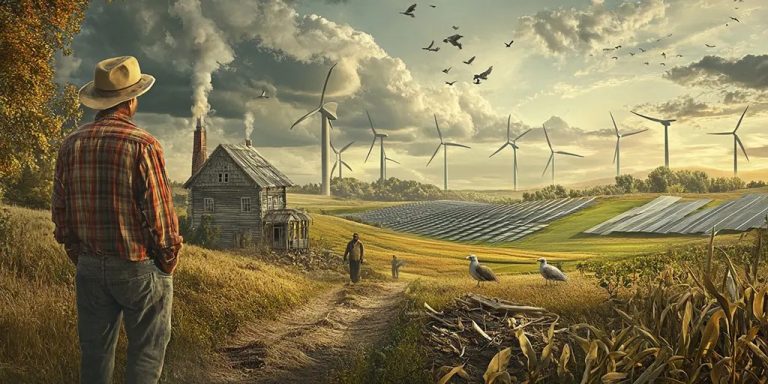Rural and coastal little guys delay and block massive 'green' energy projects
Paul Driessen
Environmentalists insist they like “the little guys”. At least in the abstract, until these people get in the way, ask inconvenient questions, or try to block “renewable energy” projects aimed at “saving the planet” from “man-made climate catastrophe.”
Then the little guys will learn that environmentalists are actually working with (and serving) Big Wind, Big Solar, Big Utilities, Big Finance, powerful politicians, and crony bureaucrats—the climate industrial complex. If it is blocked, farm families, small rural communities and even Native American groups could face long and costly battles. But they often prevailed.
Energy analyst and journalist Robert Bryce reports that the little guys have rejected or restricted 735 U.S. wind and solar projects since 2015, including 58 solar and 35 wind projects so far this year. Transmission lines, grid-scale batteries and other plans also face growing headwinds.
Rural America does not want these large-scale facilities to disrupt traditional ways of life, harm property values, raise electricity prices, destroy important farmland and habitat, ruin the landscape, kill birds, bats and other wildlife, and create severe fires and toxic gases risk.
They don’t want their countryside to be littered with giant landfills filled with billions of tons of broken, storm-damaged and obsolete solar panels, wind turbine blades and other renewable energy waste.
The number and scale of many of the proposed projects is daunting, and the complex's dream of “transitioning” the entire United States from fossil fuels to an all-electric energy, transportation and industrial system will require even more effort.
The Lava Ridge Wind project, which would have installed 400 giant turbines on about 200,000 acres of federal land in Idaho, was scaled back after failing to reduce local and state opposition. That's 310 square miles; 5.5 times the size of Washington, DC. Most of its output will go to California, which already imports nearly a third of its electricity.
The Koshkonong solar project near Christiana, Wisconsin, will cover 6,400 acres (10 square miles) and install a 667-MWh battery storage system near a local elementary school.
The Biden-Harris plan's 30,000 megawatts of offshore wind energy translate into 2,500 12-megawatt turbines 850 feet above the waves. But all those turbines won’t provide enough power (31,541 MW) to New York state during hot summers, if The wind is blowing.
The state plans to spend $2 billion to purchase 24,000 MWh of backup batteries for windless/sunless days, which will provide enough power for the state 45 minutes! Sufficient batteries would cost trillions of dollars.
Each offshore blade is 350 feet long and weighs 140,000 pounds; 25,000 turbines means nearly 500 miles of blades weighing 1,050,000,000 pounds! Imagine the cleanup and landfill costs after a major hurricane.
However, a 2020 report from Princeton University called for a massive expansion of U.S. wind and solar power capacity to combat climate change and rebuild the United States.
However, as Mr. Bryce noted, the plans would require solar projects covering the combined acreage of Massachusetts, Rhode Island and Connecticut, as well as land acreage covering Illinois, Indiana, Ohio, Kentucky and Tennessee. Wind power facilities!
That doesn’t include the wind and solar power needed to charge grid-scale backup batteries to store enough power to power the United States for a day or week of windless, sunless days.
Other projects are equally large, expensive and exotic.
Summit Carbon Solutions wants to build a pipeline to transport carbon dioxide from 57 ethanol plants in five states and inject the carbon dioxide into geological formations beneath North Dakota. Summit can't guarantee that the pressurized gas will stay underground and not erupt suddenly and violently, rapidly displacing breathable air and killing wildlife and humans—as the natural carbon dioxide reservoir of Cameroon's Lake Nyos did in 1986 That way.
this Grand total The impact of all these wind, solar, batteries, transmission lines and other projects on land, wildlife, homes, budgets and human health will be immeasurable.
In addition to cost, construction and raw material demands, home, community and regional power grids must expand and upgrade to cope with ballooning power demands and the surges and dips associated with unpredictable, weather-dependent wind and solar power.
None of this has anything to do with members of the climate-industrial complex looking to virtue-signal and praise the “critical role” they play in driving America's “renewable energy transition,” meeting arbitrary greenhouse gas reduction targets and preventing “climate catastrophe.”
Property rights advocate Tom DeWeese said concerned citizens can fight back by asking tough questions about these policies and programs. For example:
* What benefits does our community receive from the large solar and wind farms we already have? Are we already paying the price from taxpayer subsidies and interest rate increases? What benefits will we get from the big new projects you are promoting now?
* Why are you trying to end local land use controls, use eminent domain to take our property, and destroy small local and minority businesses to build these huge projects?
* If China and India alone are responsible for 38% of the world's greenhouse gas emissions (compared to 11% for the US), how will destroying our wild and agricultural areas, killing wildlife and lowering our living standards reduce the global greenhouse effect and “save Earth”? New coal-fired power plants being built every week?
Proud, principled and outspoken resistance is essential if citizens are to defend their jobs, land, health, living standards and freedoms.
Paul Driessen is senior policy advisor at the Commission for a Constructive Tomorrow (www.CFACT.org) and the author of books and articles on energy, environment, climate and human rights issues.
This article originally appeared in The Washington Times online (10/22/24) and in print (10/23/24).
https://www.WashingtonTimes.com/news/2024/oct/22/environmentalists-detest-little-guys-who-get-in-th
Relevant
